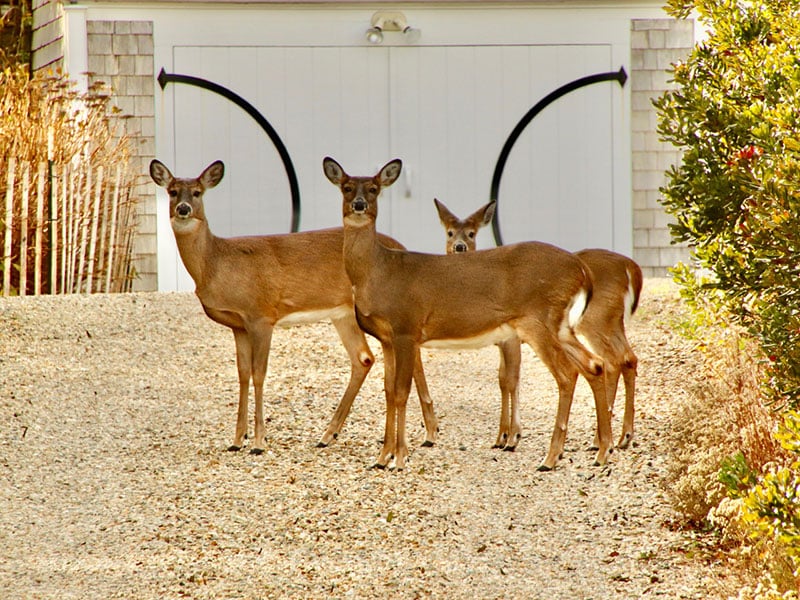by Dr. Sarah Treanor Bois, PhD
Director of Research & Education at the Linda Loring Nature Foundation
If you ask anyone around the town of Nantucket how the deer came to the island, you may have some variety of answers, but generally “they swam” and “they were brought here” will be the primary responses. There is a local legend or old wives’ tale that states that our current population of more than 2,000 animals are descended from just three deer.
Just three deer?! That seems odd, and why three? Well, there is an interesting account that helps detail the three-deer story. According to an article from 100 years ago in a 1922 edition of the Inquirer and Mirror, a male deer was found swimming by a fishing boat. The anglers “rescued” the deer and brought the buck back to their home port of Nantucket. Although white-tailed deer remains are known from Wampanoag archeological sites on-island, the archeological record for this animal dwindles in the 17th and 18th centuries. This means there were no deer by the 1920s on Nantucket.

This lone buck then became something of a local novelty and people would note sightings of him. After a few years, in 1926, people began to talk about how lonely the deer must be. Two does from Michigan were then brought to the island by summer resident Breckinridge Long and released somewhere in Squam area to “keep the solitary buck company.” This scenario implies that the thousands of deer on Nantucket today are descended from these three original animals. The fun thing about legends and local myths is that there is generally some kernel of truth in them. In 2016, I talked about this bit of local history with a friend who was a professor at Framingham State University (FSU). He then talked up the story to his colleague, Dr. Richard Beckwitt, a molecular biologist at the FSU Biology Department. Rick wanted to use the Nantucket story to motivate his undergraduate students in their “Research Experience in Biology” class. They used the question of the three deer as a starting point for learning how to collect DNA samples, amplify the DNA in the lab, and test for the genetic signature ofmitochondrial DNA. The known history of a population is an unusual situation where studies on genetic bottlenecks and founder effect can be conducted. With an interest in solving a folklore mystery and the need for a hands-on project for his students, starting in 2016, Dr. Beckwitt and his students, with the help of local research partners, collected fresh deer fecal samples from across our island. They also collected tissue samples from the deer check station during shotgun hunting season to examine the mitochondrial DNA sequences.
Mitochondrial DNA sequences are inherited from mother to daughter in the female lineage without combination with the paternal genetics. Therefore, if the Nantucket story is true, the deer population should only have two major mitochondrial types all inherited from the two original female deer imported from Michigan.
The first bit of background research led to finding evidence of more deer introductions. The Inquirer and Mirror noted two more introductions of deer: two bucks in 1935 and another three does from New Hampshire in 1936. These introductions were done to “improve the stock.” By that time (1935), nearly ten years after the original introduction of does to Nantucket, the herd had become so large they were becoming a menace to farmers’ crops and a hunt was started. The herd was estimated to include about 400 deer in 1936. That’s pretty rapid growth in ten years for just two does. However, without predators and an abundant food supply, it seems like the population growth could continue. The deer were also beloved by many in the community. There was even an editorial in the Inky calling for the protection of the deer herd.
With this information, the investigation by Rick and his students became looking into the origin of our herd from 8 deer: still a small number to begin a population. There are clear genetic consequences for starting a population with so few individuals, a concept known as “the founder effect.” With an estimated 2,000-3,000 deer on-island, that could be a serious genetic bottleneck, possibly with lots of inbreeding.
If there were only five founding females (plus three males) for the Nantucket population, there should only be five distinct mitochondrial DNA sequences (haplotypes) found in deer on the island. In addition, if the two founding females came from Michigan, then mitochondrial DNA sequences from Nantucket should more closely resemble those of the Midwestern United States than those found on the mainland of New England
After DNA was extracted and amplified allowing for analysis, samples were compared to New England mainland deer genetics as well as Michigan deer to test the story. In addition to Massachusetts and Michigan, deer tissue was donated from Connecticut, Rhode Island, Maine, and New York. Rick also wanted to look more broadly at New England deer, comparing their genetics in an effort to learn more about patterns of deer movement throughout the region.
The results are preliminary at this stage because there is more analysis to do of additional samples, but what Rick has been able to look at through the years does tell an interesting story.
First: there were three haplotypes for Nantucket; three types of mitochondrial DNA. Haplotype H1 is the most common and is very close to a haplotype from Michigan. H2 (a second haplotype) is the second most common and it is identical to a haplotype from Michigan. These two (H1 and H2) make up 95% of all the haplotypes on Nantucket (more than 70 deer genetics represented). The third haplotype, H3, makes up about 2-3% of the Nantucket deer sampled—H3 is identical to mainland Massachusetts and Connecticut deer.
So, the original story of three deer appears to be true. With Michigan deer haplotypes found in 95% of Nantucket deer sampled, those Michigan does brought to the island in 1926 are responsible for the bulk of our current population. Further introductions, whether from the additional 1930s deer or individuals swimming across the Sound, have contributed some, but not much genetic diversity to the population.
In fact, compared to Canada, Michigan, and other parts of New England, the genetic diversity of Nantucket deer is quite low, a factor supporting the founder effect hypothesis of only a few individuals “founding” the population.
Rick and his students still have more samples to compare to fine-tune the story. Specifically, tissue samples from Cape Cod and Buzzards Bay deer as well as new genetic techniques to try.
For now, it’s safe to say that Nantucket lore about the deer is true. So what other Nantucket tales can we test for?
If you’d like more details about the study and to hear it from Rick Beckwitt himself, check out a recording of a Science Pub talk he gave for the Linda Loring Nature Foundation last year: youtube.com/watch?v=GI56OYVP8ro&t=1747s



